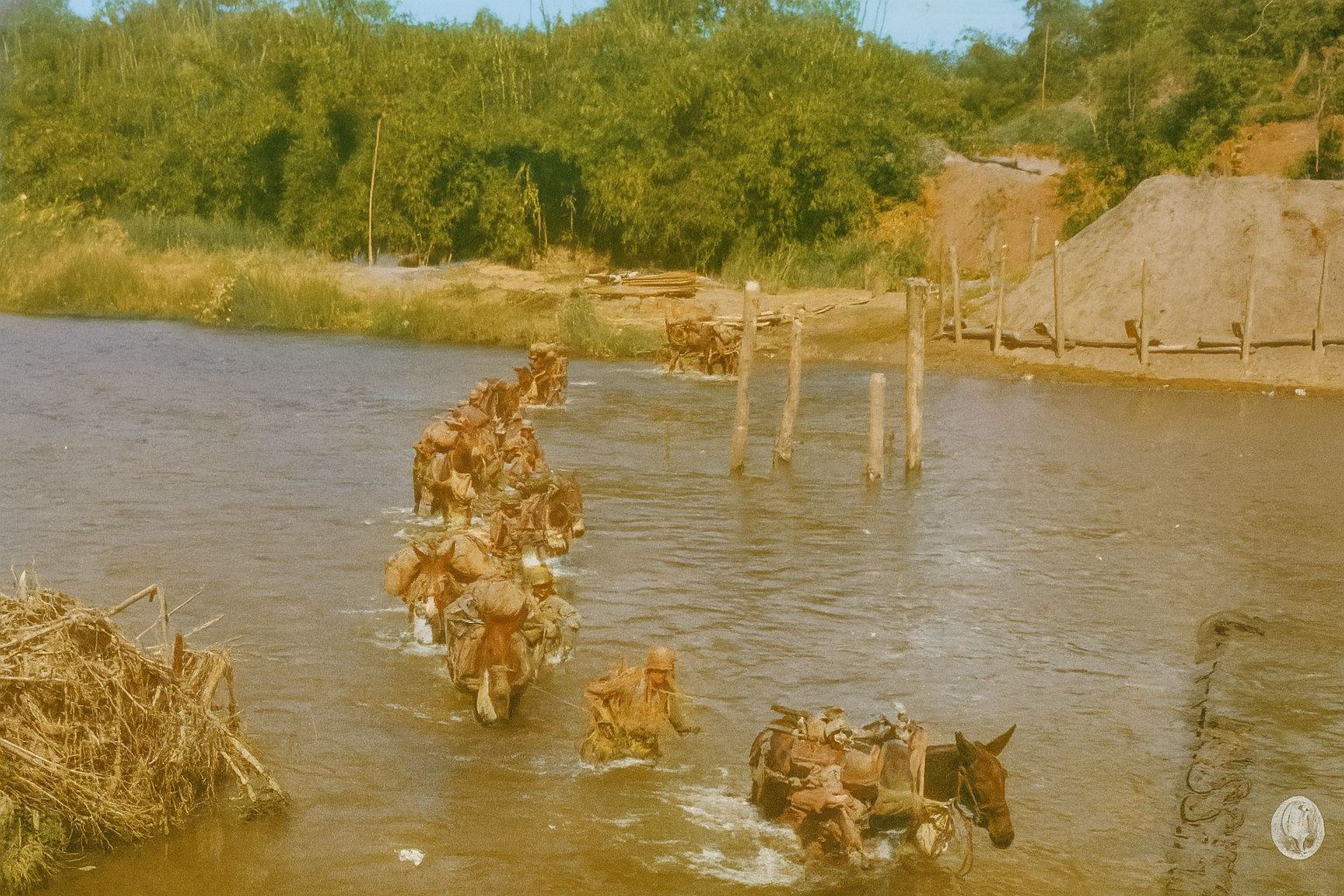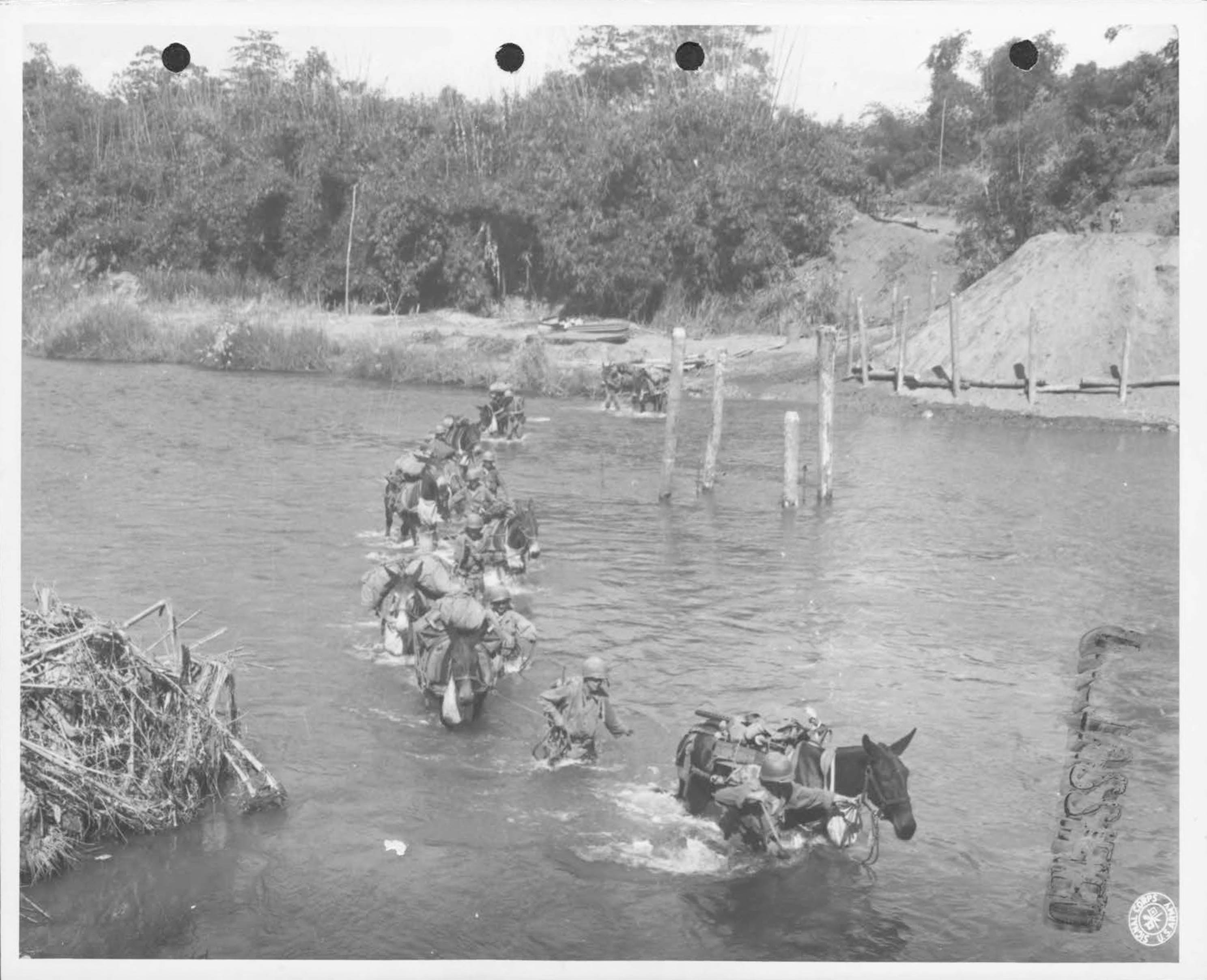The Muleskinners of the MARS Task Force
Burma's Forgotten Warriors in the CBI Theater

In the dense jungles and treacherous mountain trails of Burma during World War II, where trucks and tanks were useless and aircraft risked crashing into the rugged terrain, there was one form of transport that never failed the U.S. Army: the mule. And with those animals came the dedicated muleskinners of the 5332nd Brigade (Provisional), better known as the MARS Task Force.
Above: Army muleskinners guide their pack animals across a river during supply operations in Burma, 1944. This colorized version brings the tropical environment to life - the muddy brown water, olive drab equipment, and lush green jungle vegetation of the forgotten CBI Theater.
🐴 Who Were the Muleskinners?
Muleskinners were the soldiers trained to handle, care for, and lead pack mules through the jungle-covered mountains of the China-Burma-India (CBI) Theater. These men were critical to supplying the long-range penetration units with food, water, ammunition, and medical supplies in places where modern logistics broke down.
The Original Archival Record

The same scene in its original black and white format. This archival photograph documents the reality of supply operations in the CBI Theater, where pack mules were often the only reliable means of transport through impossible terrain.
The photographs above capture the daily reality these soldiers faced. Unlike the mechanized warfare of Europe, the CBI Theater required a return to more primitive but reliable methods of supply. Each river crossing was a carefully orchestrated operation, with muleskinners ensuring their animals and precious cargo made it safely across.
⚔️ The MARS Task Force
Formed in 1944 and modeled after Merrill's Marauders, the 5332nd Brigade was composed of battle-hardened U.S. troops including the 475th Infantry, the 124th Cavalry Regiment, and supporting artillery. Its mission: to reopen the Burma Road and disrupt Japanese forces in Northern Burma.
The Human Cost of Jungle Warfare
Army muleskinners help a mule after it slipped off a trail in Burma, 1945. This powerful image shows the daily struggles these soldiers faced - not just against the enemy, but against the unforgiving terrain itself. Every mile forward was earned through sweat, determination, and the bond between soldier and animal.
The MARS Task Force operated in some of the most grueling conditions of the war—steep trails, monsoon rains, dense jungle, malaria, and enemy ambushes. Mules and their handlers formed the literal backbone of the unit's ability to survive and move forward. As the photograph above shows, even the animals themselves required constant care and rescue operations.
📦 Logistics on Hooves
A single mule could carry about 200-250 pounds of supplies—enough to keep a squad going for days. In the remote mountains near Lashio and Bhamo, these animals were often the only supply line. Muleskinners would spend hours clearing paths, repairing loads, and even rescuing animals that had slipped down ravines or gotten stuck in river crossings like the one shown above.
The bond between muleskinner and animal was crucial. These soldiers learned to read their mules' moods, understand their limitations, and coax them through impossible terrain. Many veterans later said they trusted their mules more than their equipment.
📈 By the Numbers
- 🐾 3,000+ mules deployed in CBI jungle operations
- 👷 Hundreds of muleskinners trained in Fort Riley and India
- 📦 200–250 lbs average load per mule
- 🪖 5332nd Brigade earned the Distinguished Unit Citation
- ⚰️ Dozens of mules and skinners lost to jungle conditions and combat
- 🌊 Countless river crossings like the one captured in the photograph above
🪖 Legacy of the Muleskinners
While tanks and aircraft win headlines, the humble contributions of the muleskinners of the MARS Task Force are no less heroic. Their grit and skill kept men alive, fed, and armed in places that otherwise would've been impossible to reach.
The colorized photograph at the top of this article serves as a powerful reminder of their daily reality. Every river crossing, every mountain trail, every jungle path required the same careful coordination between man and animal that had sustained armies for centuries before mechanization.
"They were the lifeline. No mules, no mission." — Veteran of the MARS Task Force
Today, the legacy of the muleskinners remains largely unsung, but their role in one of WWII's most difficult campaigns stands as a testament to determination, endurance, and the unsung value of logistics. In the steaming jungles of Burma, where the latest military technology failed, it was the ancient partnership between soldier and pack animal that made victory possible.
🚧 Coming Soon
- OSS & CIA Origins in Cold War Europe
- The Buffalo Soldiers of WWII
- Combat Engineers: Building Under Fire
- WWII Navy PT Boats and Their Bold Missions
- Special Forces in Laos and MACV-SOG Legacy
These premium articles are coming soon. Stay tuned!